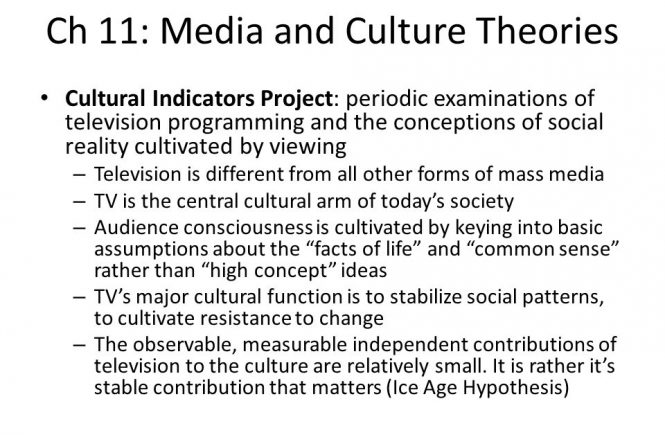MEDIA AND CULTURE THEORIES: MEANING-MAKING IN THE SOCIAL WORLD Symbolic Interactionism Symbolic Interactionism Theory that people give meaning to symbols and that those meanings come to control those people Social Behaviorism View of learning that focuses on the mental processes and the social environment in which learning takes place Symbolic interactionism was one of the first social science theories to address questions of how communication is involved with the way we learn culture and how culture structures our everyday experience. Symbolic interaction theory developed during the 1920s and 1930s as a reaction to and criticism of behaviorism, and it had a variety of labels until Herbert Blumer gave it its current name in 1969. One early name was social behaviorism. Unlike traditional behaviorists, social behaviorists rejected simplistic conceptualizations of stimulus response conditioning. They were convinced that attention must be given to the cognitive processes mediating learning. They also believed that […]
THE ROLE OF MEDIA IN THE SOCIAL WORLDNCE THEORIES
Chapter#10: AUDIEMEDIA AND SOCIETY: THE ROLE OF MEDIA IN THE SOCIAL WORLDNCE THEORIES: USES, RECEPTION, AND EFFECTS Information (Innovation) Diffusion Theory In 1962, Everett Rogers information/ innovation diffusion theory Theory that explains how innovations are introduced and adopted by various communities Meta Analysis Identifies important consistencies in previous research findings on a specific issue and systematically integrate them into a fuller understanding Early Adopters In information/ innovation diffusion theory, people who adopt an innovation early, even before receiving significant amounts of information Change agents In information/ innovation diffusion theory, those who directly influence early adopters and opinion leaders Strengths Weakness 1. Integrates large amount of empirical findings into useful theory 2. Provides practical guide for information campaigns in United States and abroad 1. Is linear and source-dominated 2. Underestimates power of media, especially contemporary media 3. Stimulates adoption by groups that don’t understand or want the innovation Social Marketing Theory […]
AUDIENCE THEORIES: USES, RECEPTION, AND EFFECTS
Chapter#9: AUDIENCE THEORIES: USES, RECEPTION, AND EFFECTS Audience Theories: From Source-Dominated to Active-Audience Propaganda theories are concerned with audiences. The power of propaganda resides in its ability to quickly reach vast audiences and expose them to the same simple but subversive messages. In these theories, the propagandist dominates the audience and controls the messages that reach it. The focus is on how propagandists are able to manipulate audiences using messages that affect them as the propagandist intends. Most are source-dominated theories. They center their attention primarily on message sources and content, not on the audiences the sources want to influence. As media theories have developed, this focus has gradually shifted. As early as the 1940s, the work of people like Herta Herzog, Paul Lazarsfeld, and Frank Stanton reflected at least the implicit concern for studying an active, gratifications-seeking audience. Lazarsfeld and Stanton (1942) produced a series of books and studies […]
FOCUS ON FUNCTIONALISM AND CHILDREN
MOVING BEYOND LIMITED EFFECTS: FOCUS ON FUNCTIONALISM AND CHILDREN Functionalism Theoretical approach that conceives of social systems as living organisms whose various parts work, or function, together to maintain essential processes Communication systems theory Theory that examines the mass communication process as composed of interrelated parts that work together to meet some goal Social cognitive theory Theory of learning through interaction with the environment that involves reciprocal causation of behavior, personal factors, and environmental events THEORIES OF THE MIDDLE RANGE AND THE FUNCTIONAL ANALYSIS APPROACH Merton (1967, p. 68) described middle-range theory as follows: Middle-range theories consist of limited sets of assumptions from which specific hypotheses are logically derived and confirmed by empirical investigation. These theories do not remain separate but are consolidated into wider networks of theory. These theories are sufficiently abstract to deal with differing spheres of social behavior and social structure, so that they transcend sheer description […]
THE RISE OF LIMITED-EFFECTS THEORY
THE RISE OF LIMITED-EFFECTS THEORY Two wars—one imaginary, one real—helped move mass communication theory away from notions of powerful and subversive mass media to a more moderate and benign view. The War of the Worlds researchers, led by Hadley Cantril, were part of a vanguard of social scientists who transformed our view of how media influence society. Within twenty years of Welles’s broadcast, the way many scholars looked at mass media had been radically altered. They no longer feared media as potential instruments of political oppression and manipulation, but instead portrayed mass communication as a relatively benign force with much potential for social good. Researchers gradually came to see media’s power over the public as limited—so limited that no government regulations were deemed necessary to prevent manipulation. limited-effects perspective The guiding idea that media have minimal or limited effects THE DEVELOPMENT OF LIMITED-EFFECTS THEORY The people who developed limited-effects theory […]
